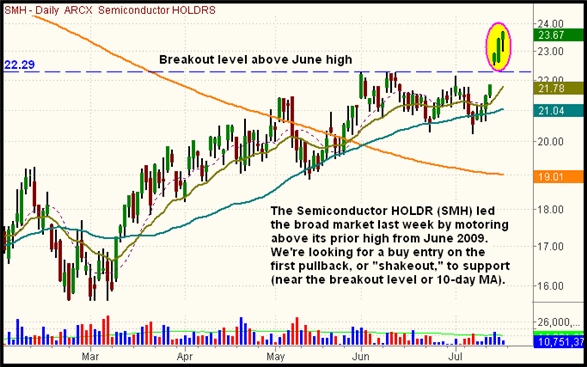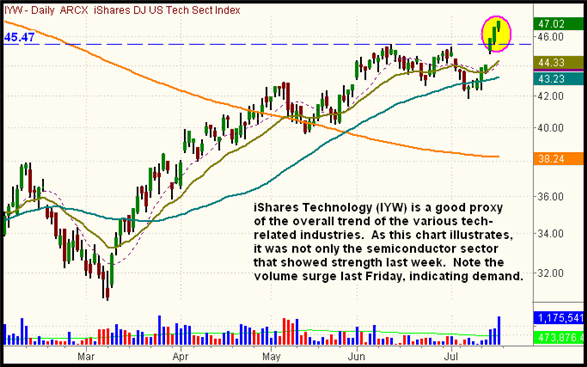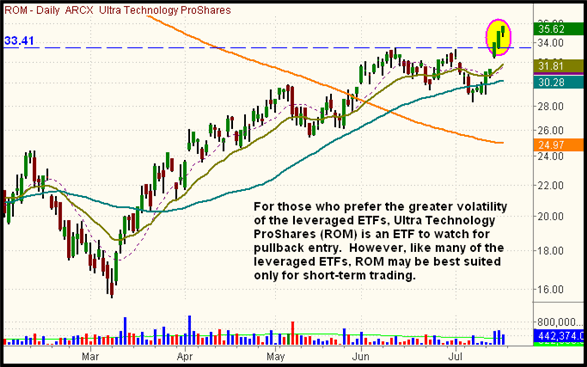|
The Wagner Daily ETF Report For July 20
Showing encouraging resilience to close the week, the major indices consolidated in a tight, sideways range throughout last Friday's session, before finishing near the flat line. The Dow Jones Industrial Average ticked 0.4% higher, the Nasdaq Composite gained 0.1%, and the S&P 500 lost less than 0.1%. The small-cap Russell 2000 and S&P Midcap 400 shed 0.5% and 0.3% respectively. The main stock market indexes closed near their intraday highs, and at the best levels of the week. The Nasdaq Composite rocketed 7.4% higher for the week, the Dow Jones Industrial Average 7.3%, and the S&P 500 7.0%.
Turnover was mixed last Friday. Total volume in the NYSE rose 10% above the previous day's level, while volume in the Nasdaq eased 10%. Monthly options expiration helped drive volume higher; otherwise, trading in the NYSE probably would have receded as well. Lighter turnover on bullish consolidation days is positive, as it indicates traders are content to sit on their positions, rather than sell into strength. In both the NYSE and Nasdaq, advancing volume was roughly on par with declining volume.
In the July 17 issue of The Wagner Daily, we looked at numerous ETF charts that were setting up for potential buy entry. However, like the major indices, most of these ETFs were little changed in the latest session. As such, they remain on our watchlist going into today. Those ETFs include: iShares Turkey (TUR), iShares South Korea (EWY), Utilities SPDR (XLU), Healthcare SPDR (XLV), CurrencyShares Japanese Yen (FXY), and CurrencyShares British Pound (FXB). But of all the various industry sectors, the technology-related ETFs are clearly showing the most relative strength right now, and are at the top of our interest list for new buys. While the S&P and Dow are still below their June 2009 highs, and the Nasdaq has only narrowly closed above its June high, the following tech-related ETFs have led the broad market by having already (convincingly) broken out above their June highs:



Although the tech sector is now looking rather strong, and is our focus for new buys, the turnaround was quite swift and sudden. Since the Nasdaq has scored eight consecutive days of gains, the reward/risk ratio of new entries at current levels may not be very ideal. Rather, we're patiently waiting for the first pullback, or "shakeout," that causes the tech ETFs to retrace to near support of their breakout levels (the dashed horizontal lines on the charts above). The 10-day moving averages (the purple dotted lines) are also used in this type of setup, as reliable levels of very short-term support. Through years of experience, we've learned the importance of waiting for proper entry points if not buying the initial breakout, rather than chasing the price action.
There's no denying the bullishness of last week's session. After being in correction mode for the past month, the major indices swiftly reversed higher, breaking out above resistance of their "swing highs" from late June. Strength in the tech sector even enabled the Nasdaq brothers (Nasdaq Composite and Nasdaq 100 indices) to move above resistance of their June 2009 highs, causing both indexes to close the week at nine-month highs. The S&P 500 and Dow Jones Industrials are still below their June highs, though certainly within striking distance. The broad-based rally that enabled the S&P and Dow to shatter their bearish "head and shoulders" patterns last week should lead to further momentum in the near-term, which should lead to a test of those June highs. Yet, until we see a breakout above those June highs, the broadening trading ranges of their daily chart patterns means the S&P and Dow are now best described as choppy.
As we're smack in the middle of corporate earnings season, renowned for its ability to throw the stock market plenty of curveballs, astute traders will approach the next few weeks with an extra ounce of caution. Nevertheless, overall sentiment has clearly become bullish, and the best odds of profitability right now should come from the long side of the market. Our short-term plan is to remain focused on initiating new long positions in ETFs showing the most relative strength, largely defined as those having already broken out above their June 2009 highs. However, because of choppy daily chart patterns in several of the major indices, we're primarily interested in buying ETFs that pull back to significant support levels after they've broken out, rather than buying the initial breakouts.
Open ETF positions:
Long - INP
Short - (none)
Deron Wagner is the Founder and Head Trader of both Morpheus Capital LP, a U.S. hedge fund, and MorpheusTrading.com, a trader education firm.
|